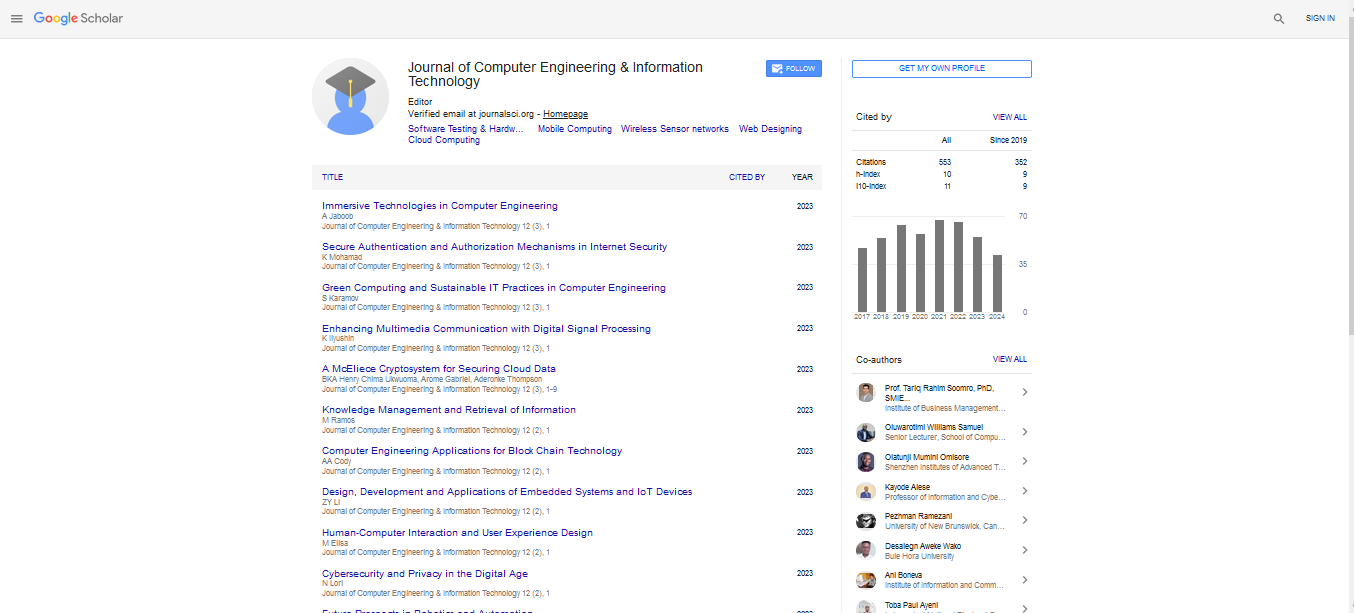Editorial, Jceit Vol: 14 Issue: 1
Digital Twin Technology: Bridging the Physical and Digital Worlds
Shual Lee*
The School of Cyber Security, University of Chinese Academy of Sciences, Beijing, China
- *Corresponding Author:
- Shual Lee
The School of Cyber Security, University of Chinese Academy of Sciences, Beijing, China
E-mail: shual@lee.cn
Received: 01-Jan-2025, Manuscript No. jceit-25-169309; Editor assigned: 4-Jan-2025, Pre-QC No. jceit-25-169309 (PQ); Reviewed: 20-Jan-2025, QC No jceit-25-169309; Revised: 27-Jan-2025, Manuscript No. jceit-25-169309 (R); Published: 31-Jan-2025, DOI: 10.4172/2324-9307.1000332
Citation: Shual L (2025) Digital Twin Technology: Bridging the Physical and Digital Worlds. J Comput Eng Inf Technol 14: 332
Introduction
In the age of Industry 4.0 and intelligent automation, Digital Twin Technology stands out as one of the most impactful innovations transforming how we design, operate, and maintain physical systems. A digital twin is a dynamic, virtual representation of a physical object, process, or system that is continuously updated with real-time data and simulations [1]. Unlike static models, digital twins evolve over time, mirroring the behavior and state of their real-world counterparts.
This technology enables unprecedented insight into operations, predictive maintenance, and decision-making, fostering a future where physical assets are not just managed—they are understood, predicted, and optimized. From smart factories and cities to healthcare and aerospace, digital twins are becoming the digital backbone of modern innovation.
How Digital Twin Technology Works
Digital twins combine several key technologies: IoT (Internet of Things) sensors, real-time data analytics, AI, machine learning, and cloud computing [2]. Sensors collect data from the physical entity, which is then transmitted to the digital replica. Algorithms analyze this data, simulate scenarios, and predict outcomes, giving operators deep visibility and control.
This continuous loop of data exchange enables the digital twin to reflect real-time performance, detect anomalies, and even recommend corrective actions. In many systems, this model becomes more than just a replica—it becomes an active participant in the operation, capable of interacting with humans and machines.
Applications Across Industries
Digital twin technology is gaining traction across multiple sectors:
Manufacturing: Smart factories use digital twins to simulate production lines [3], optimize workflows, and reduce downtime. Siemens and GE are among the pioneers in using twins for industrial optimization.
Healthcare: Digital twins of organs, or even entire patients, are being developed to personalize treatment, simulate surgeries, and predict disease progression. This could revolutionize patient care and clinical research.
Urban Planning: Smart cities leverage digital twins of infrastructure to manage traffic, energy, water supply, and emergency response systems more effectively.
Aerospace and Defense: NASA has been using digital twins since the Apollo missions. Today, they help simulate spacecraft behavior under extreme conditions, improving safety and performance.
Energy and Utilities: Utilities employ digital twins of grids and turbines to forecast demand, manage load balancing, and conduct predictive maintenance, enhancing reliability and reducing costs.
Benefits and Strategic Advantages
Digital twins offer several significant advantages:
Predictive Maintenance: By continuously monitoring asset health, digital twins can forecast failures before they occur, reducing downtime and repair costs [4].
Operational Efficiency: Real-time insights help optimize resource usage, reduce waste, and improve productivity.
Risk Reduction: Simulations allow organizations to test scenarios—like disasters or equipment malfunctions—without real-world consequences.
Innovation Acceleration: Prototypes can be tested virtually before physical production, cutting down development cycles and costs.
For decision-makers, digital twins provide a strategic edge by turning data into action with precision and speed.
Challenges and Considerations
While promising, the widespread adoption of digital twin technology faces several obstacles:
Data Integration: Creating a functional digital twin requires seamless integration of data from various sources, which can be complex and costly.
Cybersecurity: As digital twins interact with critical infrastructure, they become potential targets for cyberattacks [5].
Scalability: Maintaining multiple twins across large systems requires significant computing power and skilled personnel.
Standards and Interoperability: The lack of universal standards can hinder compatibility across platforms and devices.
Organizations must address these challenges to fully unlock the transformative power of digital twins.
Conclusion
Digital twin technology is no longer a futuristic concept—it is an operational reality that is reshaping industries, enhancing decision-making, and driving innovation. By enabling a real-time feedback loop between the physical and digital worlds, digital twins empower organizations to foresee problems, optimize performance, and adapt rapidly to change. As connectivity, AI, and cloud technologies continue to advance, the capabilities of digital twins will only expand, becoming an integral part of the digital infrastructure of tomorrow.
The future belongs to those who can harness this bridge between reality and simulation—not just to react to the present, but to anticipate and shape the future.
References
- Grieves M, Vickers J (2017) Digital Twin: Mitigating Unpredictable, Undesirable Emergent Behavior in Complex Systems. In F (Eds.) Springer.
- Tao F, Zhang M, Liu Y, Nee AYC (2019) Digital twin in industry: State-of-the-art. IEEE Transactions on Industrial Informatics 15: 2405â??2415.
- Glaessgen E, Stargel D (2012) The digital twin paradigm for future NASA and U.S. Air Force vehicles. Structural Dynamics and Materials Conference.
- Boschert S, Rosen R (2016) Digital twinâ??The simulation aspect. In P. Hehenberger 59â??74. Springer.
- IBM (2024) What is a digital twin? Retrieved from
Indexed at, Google Scholar, Crossref
Indexed at, Google Scholar, Crossref
Indexed at, Google Scholar, Crossref
Indexed at, Google Scholar, Crossref
 Spanish
Spanish  Chinese
Chinese  Russian
Russian  German
German  French
French  Japanese
Japanese  Portuguese
Portuguese  Hindi
Hindi 